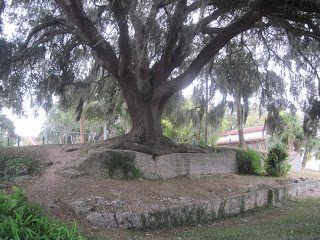As we drove over the Altamaha River bridge into Darien yesterday John kept urging me to look for Altie. Altie, sometimes known as Altamaha-ha is reported to be an aquatic cryptid whose home is in the tributaries, marshes, and former rice fields of the Altamaha River. The first reports of Altie date back to the 17th century, and the latest sighting of him was in 2002 when a fisherman saw something that fit the creature's description. Another report said that Altie swam under a boat and "whacked" it with his tail. Altie has a snake-like head that sits on a long neck, and its coloring has described as being gray, dark brown or even green on the top with a white, cream or yellow underside. Because of his particular movements in the water there is also a theory that he has two humps. I looked hard over the water with camera in hand, but did not see him. While walking on the waterfront of Darien we found a painting of Altie on a mural.
Darien, before the Civil War, was once a leading seaport of the southern coast, exporting cotton, rice and lumber. At its waterfront today are still the ruins of the cotton exchange and other business buildings of the seaport. One tabby ruin has a live oak. As a tour brochure comments, it is a testament to the survival skills of the live oak and the strength of the tabby construction.
And speaking of tabby buildings, in Darien we found St.Cyprian's Episcopal Church. This church was built in 1876 through the efforts of a Rev. James Wentworth of Hereford, England. He designated it "for the Colored People of McIntosh County". It was built by former slaves and some of the funds for it did come from England. I was impressed with its tabby walls, wooden steeple and metal roof. The side walls have stained glass windows set into the tabby. It did suffer some damage during the hurricane of 1898. What an awesome church, it just seemed to exude a feeling of strength. The church still has an active congregation.
In 1863 the town of Darien was burned by the Union Army. After the war cotton was no longer king, but the lumbering business revived the economy of Darien. Pictured below is Vernon Square; this was the social, cultural, and religious center of town during the nineteenth and early twentieth century. Prominent merchants and timber barons had their homes near here. The pictures in this posting are dark because it was a cloudy over-cast day; unfortunately the much needed rain, which was predicted, never did happen. This area has not seen rain in six weeks.
Wednesday, November 17, 2010
Subscribe to:
Post Comments (Atom)




No comments:
Post a Comment